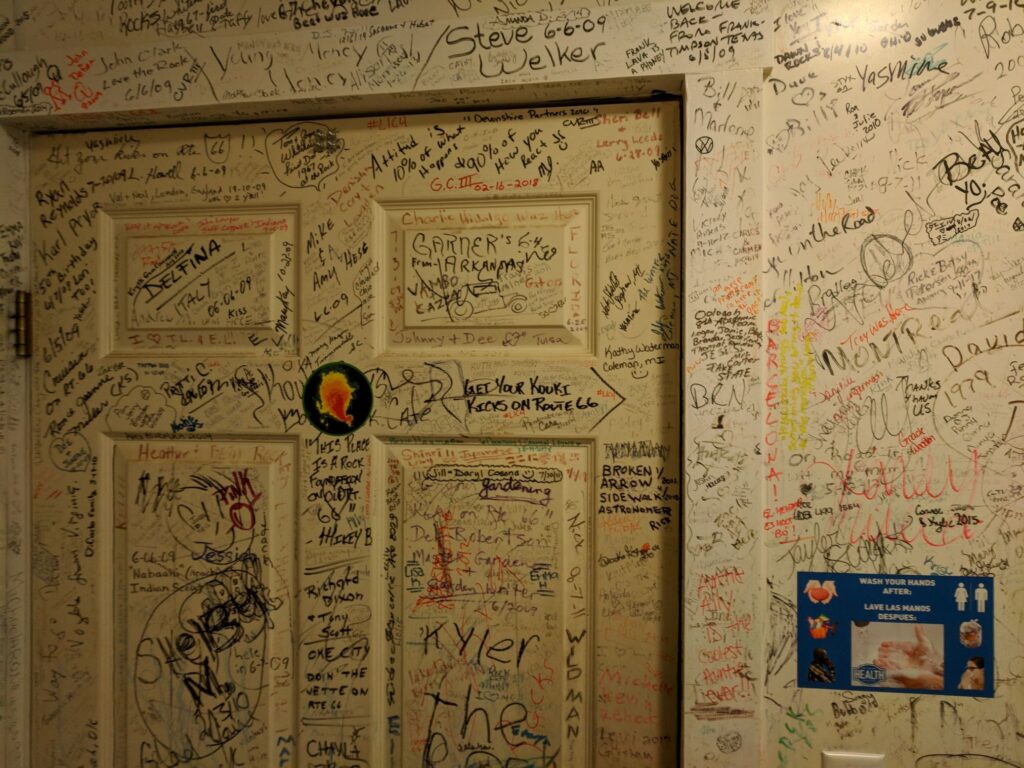May 4, 2018, Tulsa to Oklahoma City
Today we continue westward through Oklahoma. The themes are not so different from yesterday in Missouri: pride in service, helpful locals, and frustrating navigation units. Also, a small transgression and some disappointing trees.
Oklahoma is green. This is both a delight and a disappointment. I felt like I was driving through the English countryside with delightful deciduous trees lining the roads, or rather an English countryside that had been stretched in both horizontal directions, with wider margins, straighter roads and longer distances between towns. Other than the scale, only the style of buildings – wood and metal vs brick and stone – gave the game away. Anna thought it looked like parts of Ontario. At other times, driving through a tunnel of leaves formed by tree branches arching out the road, I am reminded of New England.
At the time, I was disappointed — or, at least, my expectations were frustrated — because there were no signs of dustbowl conditions in this verdant land. If it had looked like this before the dustbowl, I thought, it must have come as a terrible shock when it happened. Still, I noted, this is in eastern Oklahoma. The western half might be different when we see it tomorrow. (Spoilers: it is.)
The Garmin plays us false again, going through Oklahoma City, dumping us on the freeway and then making us cross four lanes in a couple of hundred meter to get to the next exit. The original problem came from Garmin miscounting the exits from a roundabout, after which it went to its usual dump-em-on the freeway routine. It astonishes me that no navigation device I have ever come across does the technically much simpler function of navigating the route you set for it. They all seem to come with a built in petulant insistence on doing it their way.
We have lunch at the Rock Café. The parking lot is roped off, but street parking is plentiful and marked by painted lines, so yay! (If this is the first of these posts you are reading, this is a reference to my previously mentioned citified preference for having a nice painted box to park in.)
I have bison burger. I am eating a lot of burgers on this trip. Usually I am good for one burger every couple of months, but on this trip eating them regularly. Does travelling require more beef protein?
There is further evidence of the dedication to the services here. There is a framed picture above our table of three men in uniform. Who are the young men in this picture? They obviously served. Did they die overseas, I can’t help asking myself. Or are they safe at home today? And, in the end, does that make any difference to this modest memorial? They served, and whether they came home or not makes no different to that.
Again, none of this smacks of militarism. The jingoism of some of the language seems entirely superficial, and is belied by the welcome that is extended to everyone of any origin. This is pride in service and it is impossible to regard it as anything but virtuous, whatever uses it may be put to by the people in Washington.
The bathrooms are covered in signatures and slogans. They cover the walls, the doors, even the ceilings. I add a very small inscription. In these matters I require a great deal of tacit permission to venture even the smallest transgression. (But is this even a transgression here? Context matters in cases like this.)
There is a strong Cars (the movie) theme to the place as well. Apparently the owner was the basis for a character in the movie.
The place burned down a few years ago, leaving nothing but four rock walls and the stove. It would probably have been easier to replace it with a McDonalds, but the owner rebuilt, because that is what ordinary eccentrics do. We have now eaten in establishments that survived flood and fire. I expect to hear that the next place has recovered from a plague of locusts. On the great plains that does not seem so farfetched.
Next up is the Route 66 interpretive center in Chandler OK. On the way in, a young woman offers to take a picture of us in front of the building. I thought she was an employee but later it turns out that a local high school is setting up for prom in the hall and I suspect she was on of the students doing the set up. I cannot imagine that happening in a city. No student there would even acknowledge the existence of two old fogies like us, let alone interact and volunteer. City folk have to ignore each other. There are too many people to interact with them all. Rural people see each other, and see and welcome strangers. I wish I could live like that again.
Our guide/ticket seller/gift shop attendant takes us and another couple on a guided tour. He is actually more interested in showing us the armory than the Route 66 museum it houses. It is one of the few local armories that was saved from the bulldozers. (Though the walls are so thick and so stout here that I imagine the bulldozers must have had quite a fight on their hands to knock any of them down.)
I find it remarkable that there were several armories in several small Oklahoma towns, but our guide explains that the National Guard is huge here. Here is that dedication to service again.
The building was erected as part of the WPA and all the stone was cut and shaped by hand by local men. One of the shaping tools is hanging on a ring in the wall, convenient for demonstrations.
The town is clearly proud of the armory. I suspect that putting a Route 66 interpretive center in it was just a ploy to get people to stop in so they could brag about the armory. And, honestly, it is a more interesting story than anything in the Route 66 interpretive center itself, which is mostly a collection of interpretive glass panels, one per state, and a set of short videos. The most interesting thing about the interpretive center is that the chairs for the videos are from vintage cars, plus a couple of mattresses from former mom and pop motels (sealed in plastic, the host assures us).
I watched a video from the driver’s seat of a 60s Mustang. You would think that driving Route 66 in a 60s Mustang would be the definition of cool, and that may be so, but it would not be the definition of comfort. I’m glad I am not driving across the continent in that seat. No amount of cool factor would entirely make up for the sore bum.
We stop at a Barnes and Nobel because Anna wants a copy of The Grapes of Wrath. And since we are in the Steinbeck section, I pick up a copy of Travels With Charlie in Search of America. Seems appropriate.
Walmart for salads. If you can’t eat authentic, eat healthy and sparingly.







